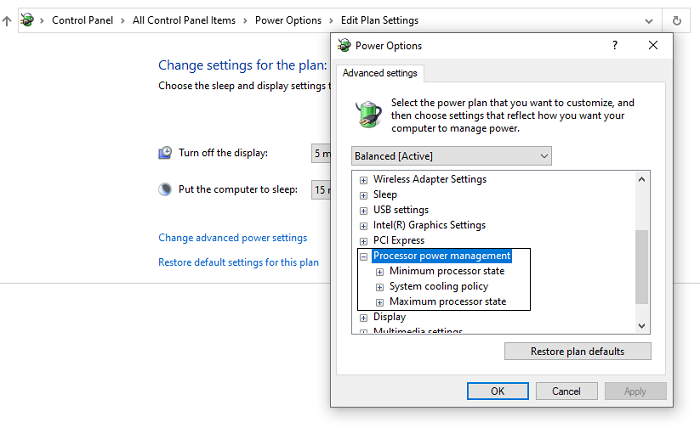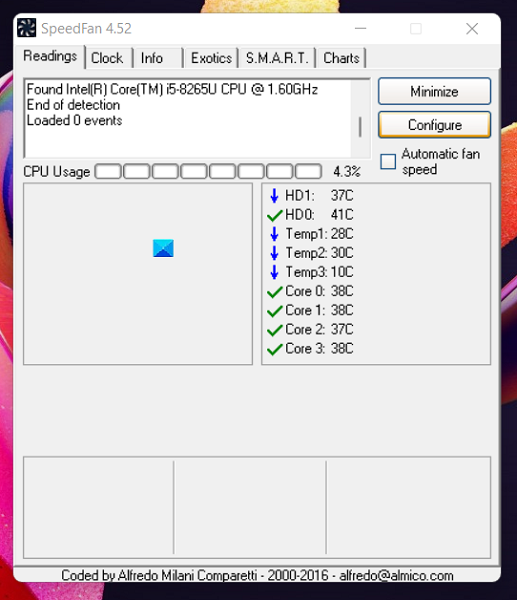Typically, CPU fan noises are heard when you reboot your PC (the whirring sound you may have heard upon startup) and it goes on to decline as the startup process completes. The purpose of fans on your CPU is to blow off the heat that your processor may generate when a process is going through. You may have felt your PC getting hot when it’s riddled with many windows and applications, and it subsequently cooled down in a while; it’s the fans at play. In this article, we will be discussing how you can control the speed of your CPU fans on Windows.

Why is it important to monitor CPU Fan Speed in Windows?
The mechanism of CPU fans is pretty straightforward. They keep a periodic check on your PC’s temperature and get turned on and off accordingly. Every PC has air vents to allow the heat to escape. If you find your CPU fans to be running constantly, it’s a sign that your system is overloading, and that may cause problems with your power adapter, too. Thus, it can be very important to maintain a balance with the CPU fan speed while also keeping your PC’s temperature in check.
Your computer fan may rev up due to excessive heat as it works to cool down internal components. This can occur when running intensive programs or if airflow is obstructed. Additionally, accumulated dust can hinder performance, prompting fans to work harder.
How to control Fan Speed on Windows 11/10
You can check, control, increase, monitor or change the CPU Fan Speed safely in Windows 11/10 by following these steps. Here, we will be primarily discussing how you can keep your CPU fan speed in check using the Control Panel, your PC’s BIOS control, or a third-party fan controller SpeedFan.
- Control CPU fan speed via the Control Panel
- Use BIOS/UEFI to control the CPU fan speed
- Control CPU Fan speed using SpeedFan.
1] Control CPU fan speed via the Control Panel

Here’s how you can access fan control settings in your Control Panel:
- Open the Control Panel and click on Hardware and Sound
- Here, click on Power Options and further select Choose when to turn off the display
- Open the Advanced power settings page
- From this subsequent dialog box, locate Process power management
- Here, select System Cooling Policy and toggle the setting to ‘Active’
Save these changes by clicking on Apply and you can then exit the window. The System Cooling option is absent in Windows 11 computers, so if you’re using that version of the Windows OS then you should go for the second and third ways.
Read: Best Laptop cooling software.
2] Use BIOS/UEFI to control the CPU fan speed
The Advanced Startup option BIOS has fan controlling settings in it which may differ based on your computer. Here’s how you can access and modify those settings:
How to open BIOS settings
- You can either restart your PC and when it boots back up, press the ‘Delete’ and ‘F12’ keys together
- Alternatively, you can follow this trajectory: Settings > Update & security > Recovery > Advanced Startup > Restart Now > Troubleshoot > Advanced options > UEFI Firmware settings > Click Restart
How to use BIOS
- On the BIOS front page, locate Fan Control Settings
- Go to Monitor > Status > Fan speed control
- Here, look for RPM settings. Once found, select the CPU fan to increase or decrease its speed with RPM as a unit
- Save these changes and press Esc till you reach the menu option.
Read: Best practices to keep your computer cool.
3] Control CPU Fan speed using SpeedFan

The free app SpeedFan can help you find the cause behind a heightened CPU fan speed with ease. It searches your computer for informative chips and puts up voltages, speeds, and temperatures on display (things that your BIOS may fall short on). SpeedFan’s technology known as S.M.A.R.T. (Self-Monitoring Analysis and Reporting Technology) runs through your motherboard and video cards to extract relevant data. Here’s how you can use it.
- Download, install and run the app on your PC
- When the app’s main window opens, select Configure
- Now, visit the Fans tab and wait for a list of all the fans on your PC to show up
- Select the CPU fan and use the Response curve to adjust its speed
The Response curve plots down the PC’s temperature and the relevant fan speed. The upward-sloping graph suggests that higher temperature leads to higher fan speed, but you can configure that to your liking.
There are several free fan speed controller software like SpeedFan and HWinFo, so if you don’t find its interface or control effective enough, you have got other options. If you’re looking to go overboard, you can always purchase an external fan hub (for your desktop) or a cooling pad for your laptop.
Note: The CPU Fan error is usually triggered when you’ve turned on your PC. As such, the fan error occurs before Windows 10 OS boots and is probably caused due to some hardware issue, and It may not be due to overheating. The most common cause why a CPU fan would run at full speed is that its sensor is not working properly. The solution here is to replace the fan itself. But you need to see that the processor is not always hot. You can use third-party applications for this purpose. These posts will help you if a CPU Fan Speed Error is detected or your CPU Fan runs at full speed always. You may want to also to check your PC’s total power consumption.
PC Fan speed increases automatically in Windows 11
If your Fan speed increases automatically and randomly in Windows 11/10, immediately open the Task Manager when this happens and see which process is consuming high CPU or another resource. Once you have identified this, you must find out why that is happening. If that does not help, clean your fan and keep it dust-fee or take it to a technician to check it out.
Your CPU fan may ramp up due to overheating or dust accumulation. If the processor’s temperature rises above normal, the fan increases speed for cooling. Subsequently, it slows when the temperature stabilizes.
However, your PC fan may speed up unexpectedly due to underlying processes such as software updates, background tasks, or antivirus scans, even if you’re not actively using resource-heavy applications.
How do I check my fan speed in Windows?
Open your UEFI and head to the Monitor section. Here you can see the fan speeds and temperature. Alternatively, you can use a free third-party temperature and fan monitoring tool like SpeedFan to check your PC’s fan speed.
How do I adjust my fan speed?
There are mainly three different ways to adjust your fan speed on your computer. For example, you can do that using Control Panel, BIOS/UEFI, and third-party software. In case you want to use a third-party tool, you can opt for SpeedFan. On the other hand, you need to look for the Processor power management setting in the Power Options to get the job done.
Read next: How to make your computer run like new again.
Leave a Reply